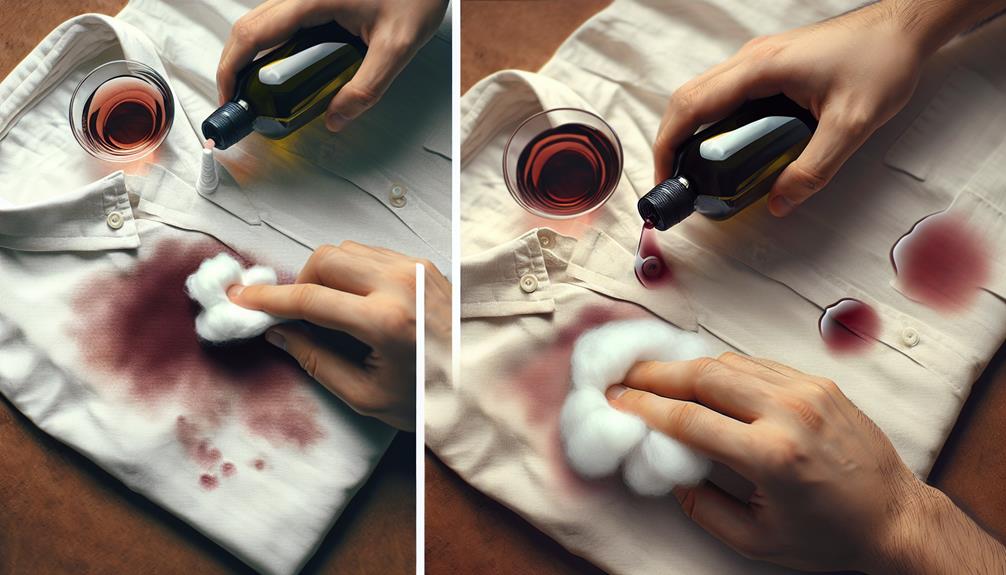When it comes to tackling stains, the question often arises: can rubbing alcohol really do the trick?
I've encountered the same inquiry numerous times and was pleasantly surprised by the effectiveness of this household item.
Before you dismiss it as just another cleaning myth, let's explore the science behind rubbing alcohol's stain-removing capabilities and how it might just revolutionize your cleaning routine.
Table of Contents
Key Takeaways
- Rubbing alcohol effectively removes ink, grease, food, and gum stains.
- It penetrates and breaks down stains on fabrics, carpets, and surfaces.
- Quick drying and versatile, rubbing alcohol ensures efficient stain removal.
- Safety precautions and alternative options enhance the effectiveness of rubbing alcohol.
Types of Stains Rubbing Alcohol Can Remove
Rubbing alcohol can effectively remove stains such as ink, marker, and certain types of food stains. When it comes to ink stains, rubbing alcohol is a lifesaver. Whether it's a pen that leaked in your pocket or a mishap while writing, rubbing alcohol can help lift the ink out of various surfaces. By dabbing a cotton ball soaked in rubbing alcohol on the ink stain and gently blotting, you can see the ink transferring onto the cotton ball, gradually lifting the stain.
Grease marks are another common stain that rubbing alcohol can tackle with ease. Whether it's from cooking oil splatters or a greasy handprint on furniture, rubbing alcohol can help break down the grease. Simply apply a small amount of rubbing alcohol to the grease mark, let it sit for a few minutes to penetrate the grease, then gently wipe it away. The alcohol helps to dissolve the grease, making it easier to remove without leaving a residue behind.
Benefits of Using Rubbing Alcohol
I love using rubbing alcohol for removing stains because of its incredible stain removal power and its ability to dry quickly, making the cleaning process efficient.
It's a versatile solution that can tackle a variety of stains on different surfaces with ease.
Plus, the convenience of having rubbing alcohol readily available in most households makes it a go-to option for quick and effective stain removal.
Stain Removal Power
With its powerful stain removal capabilities, rubbing alcohol is a versatile and effective solution for tackling tough stains on various surfaces. Here are some benefits of using rubbing alcohol for stain removal:
- Fabric stains: Rubbing alcohol can effectively remove ink, grass, or oil stains from clothing and other fabrics.
- Carpet spills: It can help lift and eliminate stubborn stains like coffee, wine, or pet accidents from carpets and rugs.
- Quick action: Rubbing alcohol works fast to break down stains, making the cleaning process more efficient.
- Versatility: From clothes to countertops, rubbing alcohol can be used on a wide range of surfaces for effective stain removal.
Harness the stain-fighting power of rubbing alcohol for a spotless finish every time.
Quick Drying Solution
When seeking a quick drying solution for various surfaces, consider the benefits of utilizing rubbing alcohol. Rubbing alcohol is a quick fix that can serve as an emergency solution for drying surfaces efficiently. Its fast evaporation rate makes it ideal for situations where a speedy drying process is necessary. Check out the table below for a visual representation of the benefits of using rubbing alcohol as a quick drying solution.
| Benefits of Rubbing Alcohol for Quick Drying |
|---|
| 1. Fast evaporation rate |
| 2. Versatile application |
| 3. Non-streaking formula |
| 4. Cost-effective solution |
| 5. Quick and efficient drying |
How Rubbing Alcohol Works on Stains
I'll explain how rubbing alcohol tackles stains and its effectiveness on various types of stains. Understanding the mechanism behind its stain removal properties can help us utilize it more efficiently.
Different types of stains may react differently to rubbing alcohol, so knowing which stains it works best on is important for successful stain removal.
Stain Removal Mechanism
Understanding the process by which rubbing alcohol effectively removes stains can provide insight into its cleaning capabilities. When rubbing alcohol comes into contact with a stain, it initiates a chemical reaction that helps break down the stain molecules. The solvent properties of rubbing alcohol allow it to dissolve the stain, making it easier to lift off the surface. Here's how rubbing alcohol works on stains:
- Penetration: Rubbing alcohol penetrates the stain to reach deeper layers.
- Breakdown: It reacts with the stain, breaking down its chemical structure.
- Dissolution: The solvent properties dissolve the stain particles.
- Lifting: Finally, the loosened stain is lifted off the surface with a cloth or sponge.
This mechanism showcases rubbing alcohol's effectiveness in stain removal.
Effectiveness on Different Stains
How does rubbing alcohol effectively tackle different types of stains?
Rubbing alcohol is versatile in its effectiveness on various stain types due to its solvent properties. For organic stains like food or blood, rubbing alcohol can break down the molecules, making them easier to lift from the fabric. Ink stains are also no match for rubbing alcohol, as it dissolves the pigments. When dealing with grease or oil-based stains, rubbing alcohol works by cutting through the oils, allowing for easier removal.
To maximize its effectiveness, apply rubbing alcohol directly onto the stain, let it sit for a few minutes to penetrate, then blot or gently rub the area. Remember to test on a small, inconspicuous area first to ensure compatibility with the fabric.
Precautions When Using Rubbing Alcohol
When working with rubbing alcohol, always prioritize safety by following essential precautions.
- Proper Ventilation: Make sure you're working in a well-ventilated area to prevent inhaling harmful fumes.
- Avoid Skin Contact: Wear gloves to protect your skin from irritation or drying out due to the alcohol's properties.
- Flammability: Keep rubbing alcohol away from flames or heat sources as it's highly flammable.
- Eye Protection: In case of accidental splashes, wear safety goggles to shield your eyes from potential harm.
These precautions are important to prevent accidents and make sure a safe working environment when using rubbing alcohol.
Steps to Remove Stains With Rubbing Alcohol
After making sure the necessary safety measures when working with rubbing alcohol, let's now explore the effective steps to successfully remove stains using this versatile solution.
For wine spills on clothing, start by checking the area with a clean cloth to absorb excess liquid. Then, dab a small amount of rubbing alcohol onto the stain and gently check until the stain lifts. Wash the garment as usual to remove any remaining residue.
When dealing with carpet stains, mix one part rubbing alcohol with two parts water in a spray bottle. Spray the solution onto the stained area, let it sit for a few minutes, then check with a clean cloth. Repeat if necessary until the stain disappears.
For furniture restoration, test a small, inconspicuous area first to make sure the rubbing alcohol doesn't damage the material. If safe, dab rubbing alcohol onto a cloth and gently rub the stained area. Finish by wiping with a damp cloth and allowing it to air dry.
Alternatives to Rubbing Alcohol for Stain Removal
While rubbing alcohol is a common stain removal solution, there are alternative methods that can also effectively tackle tough stains. When dealing with stains, it's helpful to have a few tricks up your sleeve. Here are some alternatives to rubbing alcohol for stain removal:
- Vinegar solution: Mix equal parts white vinegar and water to create a potent stain-fighting solution. Vinegar is acidic and can break down many types of stains effectively.
- Baking soda paste: Create a paste using baking soda and water, then apply it to the stained area. Baking soda is known for its gentle abrasive properties, making it great for lifting stains.
- Lemon juice: The citric acid in lemon juice can be a powerful stain remover, especially on organic stains like food or sweat.
- Hydrogen peroxide: This common household item can work wonders on tough stains like blood or wine. Just remember to spot test first to ensure it won't damage the fabric.
These alternatives provide effective solutions for stain removal, catering to a variety of fabrics and stain types.
Tips for Effectively Using Rubbing Alcohol
For effective stain removal, I find that utilizing rubbing alcohol can be a handy solution in my cleaning arsenal. When it comes to cleaning jewelry, rubbing alcohol can work wonders. Simply soak a cloth in rubbing alcohol and gently wipe down your jewelry to remove dirt and grime. However, be cautious with delicate gems or pearls, as rubbing alcohol may damage them.
When tackling ink stains, rubbing alcohol is my go-to remedy. Place the stained fabric on a clean cloth, apply rubbing alcohol to the stain, and gently dab until the ink transfers to the cloth. Repeat if necessary and then wash the fabric as usual.
Here are some tips to effectively use rubbing alcohol for cleaning jewelry and removing ink:
| Cleaning Jewelry | Removing Ink |
|---|---|
| Soak cloth in rubbing alcohol | Place fabric on clean cloth |
| Gently wipe jewelry | Apply rubbing alcohol to stain |
| Avoid delicate gems | Dab gently until ink transfers |
Common Household Items Rubbing Alcohol Can Clean
When exploring the cleaning potential of rubbing alcohol, one may be surprised by the range of common household items it can effectively clean. Here are four items that rubbing alcohol can tackle with ease:
- Wine spills: Rubbing alcohol is excellent for lifting red wine stains from carpets, upholstery, and clothing. Simply dab the affected area with a cloth soaked in rubbing alcohol, and watch the stain disappear.
- Grease marks: Whether it's on kitchen countertops, appliances, or even clothing, rubbing alcohol can cut through grease and leave surfaces sparkling clean. Just apply a small amount to a cloth and wipe away the grease effortlessly.
- Glass and mirrors: Mix rubbing alcohol with water in a spray bottle for a streak-free solution to clean glass surfaces and mirrors around your home.
- Electronic devices: Use rubbing alcohol to clean and disinfect electronic devices like smartphones, tablets, and keyboards. It evaporates quickly, making it safe for electronics.
With rubbing alcohol in your cleaning arsenal, these common household items can be effortlessly restored to their pristine state.
Frequently Asked Questions
Can Rubbing Alcohol Be Used on Delicate Fabrics or Materials?
I use rubbing alcohol cautiously on delicate fabrics or materials like silk garments, leather accessories, fine china, and delicate lace. Testing a small hidden area first to make sure it won't cause damage is crucial.
Is Rubbing Alcohol Safe to Use on Colored Fabrics or Will It Cause Fading?
Colorfastness concerns with rubbing alcohol on colored fabrics are valid. Always test on a hidden spot first. If safe, dab gently to remove stains. Fabric compatibility varies; proceed cautiously to prevent fading or damage.
Can Rubbing Alcohol Remove Set-In Stains That Have Been There for a Long Time?
Deep cleaning with rubbing alcohol can tackle tough stains that have been there for a long time. I've witnessed its effectiveness firsthand on various surfaces. Its solvent properties break down stains, making removal easier.
How Long Should You Let Rubbing Alcohol Sit on a Stain Before Attempting to Remove It?
When pre-treating stains with rubbing alcohol, letting it sit for about 5-10 minutes before attempting removal can be effective. This time-saving method allows the alcohol to penetrate the stain, making it easier to lift off fabric or surfaces.
Are There Any Specific Types of Stains That Rubbing Alcohol Is Not Effective in Removing?
Certain tough stains, like ink and blood, may not be effectively removed by rubbing alcohol. In such cases, alternative solutions like hydrogen peroxide or enzyme-based cleaners might be more suitable for tackling these types of stains.
- Tetron Fabric for Marine Applications: Durability and Use Cases - June 18, 2025
- Tetron Fabric for Outdoor Furniture: Weather Resistance and Care - June 18, 2025
- Tetron Fabric for Wall Coverings: Style and Application Tips - June 18, 2025






